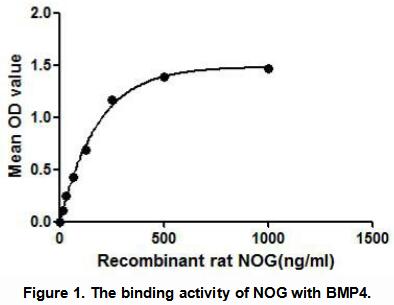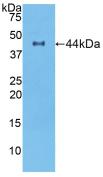
Details
ACTIVITY TEST
Buffer Formulation 20mM Tris, 150mM NaCl, pH8.0, containing 1mM EDTA, 1mM DTT, 0.01% SKL, 5% Trehalose and Proclin300. Traits Freeze-dried powder Purity > 90% Isoelectric Point 10.0 Applications Cell culture; Activity Assays.

NOG (Noggin) is a signaling molecule that plays an important role in promoting somite patterning in the developing embryo, essential for cartilage morphogenesis and joint formation. It is considered as an inhibitor in bone morphogenetic proteins (BMP) signaling, by binding with BMP4, thus a binding ELISA assay was conducted to detect the association of recombinant rat NOG with BMP4. Briefly, NOG were diluted serially in PBS with 0.01%BSA (pH 7.4). Duplicate samples of 100uL were then transferred to BMP4-coated microtiter wells and incubated for 2h at 37°C. Wells were washed with PBST and incubated for 1h with anti-NOG pAb, then aspirated and washed 3 times. After incubation with HRP labelled secondary antibody, wells were aspirated and washed 3 times. With the addition of substrate solution, wells were incubated 15-25 minutes at 37°C. Finally, add 50µL stop solution to the wells and read at 450nm immediately. The binding activity of NOG with BMP4 was shown in Figure 1 and this effect was in a dose dependent manner.
USAGE
Reconstitute in 20mM Tris, 150mM NaCl (pH8.0) to a concentration of 0.1-1.0 mg/mL. Do not vortex.
STORAGE
Avoid repeated freeze/thaw cycles. Store at 2-8°C for one month. Aliquot and store at -80°C for 12 months.
STABILITY
The thermal stability is described by the loss rate. The loss rate was determined by accelerated thermal degradation test, that is, incubate the protein at 37°C for 48h, and no obvious degradation and precipitation were observed. The loss rate is less than 5% within the expiration date under appropriate storage condition.
Image

SDS-PAGE Image

Figure. Western Blot; Sample: Recombinant NOG, Rat.
Bought notes(bought amounts latest0)
User Comment(Total0User Comment Num)
- No comment


 +86 571 56623320
+86 571 56623320
 +86 18668110335
+86 18668110335

